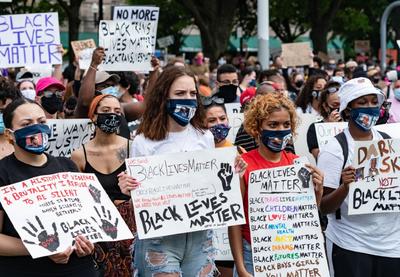I am not Black; I am a Middle Eastern Muslim woman who wears hijab. Although Middle Eastern Muslims face bias and Islamophobia on a daily basis, the community I come from has not experienced the same abuse that the Black community has received.
But my emotions have been high since the death of George Floyd. I can identify with the fear of being pulled over by police while being alone or anger when I cannot attain opportunities because of the way I look. What Black and brown people have in common is that we all are fighting hate towards us in this country. Our communities must be co-conspirators that stand together with the Black Lives Matter movement.
Even though the non-Black communities of color face their own systemic barriers, displays of anti-Blackness flared within them this summer in response to the protests. It hasn’t helped that much of our national conversation about racism—and most coverage of Black Lives Matter protests—tends to fall along lines of Black and white. Students who don’t identify as Black or white may feel confused about the movement or feel like they don’t have any voice in the dialogue.
In response, educators should be ready to lead diverse classrooms into conversations about the Black Lives Matter movement and guide non-Black students of color in understanding the history of anti-Blackness. They should encourage a co-conspirator classroom, where students learn about and conquer their own biases, reflect on structural inequities and support each other to push for change in their communities.
Classroom Conversations About the Movement
As protests against police brutality continue, students may need a place to process their feelings and have questions answered. The classroom—real or virtual—can provide that place. Teaching Tolerance’s Let’s Talk! guide for facilitating critical conversations is a good tool to help teachers create a community and establish norms.
Educators facilitating conversations about protests and responses to them should be empathic and recognize that some students may feel fear, anxiety or trauma around police violence they’ve seen in the media or in their communities, while others may feel anxiety and fear about violence they have seen in the media or in their communities during the protests.
Educators should be ready for students to echo rhetoric they have heard online or in their own homes. Recentering the goals of the Black Lives Matter movement, which focus on ending systematic racism and police brutality towards all people of color, will help students in understanding that violence is not part of the movement. Tracing the historical context of how the movement began, along with the movement’s mission is a good start.
If students share information about the movement that is incorrect, it is important to be ready to interrupt it. Teaching students about digital literacy before, during or alongside these conversations is especially helpful. Given the polarized response to Black Lives Matter, encouraging students to be critical consumers of information and giving them the tools they need to recognize and critique biased or fake sources are key. It will both help them understand the movement and provide a model for recognizing and interrupting racist responses to it.
Non-Black students of color can and should recognize that suffering from racism doesn’t make one immune to anti-Blackness. Critical conversations can help them understand implicit bias—ultimately supporting them in self-reflection and taking action against the biases they hold.
Participating in discussions about race and anti-Black racism helps students recognize that their own silence against racism doesn’t help the problem; it only makes it worse.
Teaching About Hard History
The success of co-conspiratorship in classrooms is reflected by students’ ability to talk about the topic of race in a way that honors the identities of all participants. Being able to participate in critical conversations about race and racism is the first step to collaboration and changemaking.
But understanding history plays a role as well. Students must learn to examine the grueling roots of anti-Black racism in this country. This history can help students understand that anti-Black racism is structural, that it’s tied to slavery, and that opportunities and access to resources have been and continue to be denied to Black communities.
Students should recognize that, while Black history is filled with joy and resistance, this history also includes racialized trauma. Students may need to be reminded that this history of anti-Blackness and this racial trauma continues to this day. Students need to understand this history—and the fact that white supremacy has both individual and structural impact—in order to process the damage of the past and to restructure communities in the future.
Having non-Black students of color draw parallels between their communities’ histories and histories of Black communities can help them empathize, connect and begin to understand co-conspiracy. Students should remember that real solidarity is not about “not being racist”—it’s about what Ibram Kendi calls “being an antiracist.”
A Community of Co-Conspirators
Teaching students ways to advocate alongside peers and communities—and for themselves—is one way to cultivate skills for promoting anti-racism.
As your classroom community builds these skills, you will be able to identify learning opportunities within your content area that will allow students to advocate for Black and non-Black communities of color. Through their learning, their co-conspiratorship can help them self-identify as change makers who will do good through collective action.
Committing to supporting non-Black students of color as they process their feelings about the Black Lives Matter movement, understand its root causes, participate in critical conversations in safe spaces and cultivate co-conspirator attitudes is an important way educators can combat anti-Black racism in this country. Standing together as communities of color will assure that hate will not prevail.
